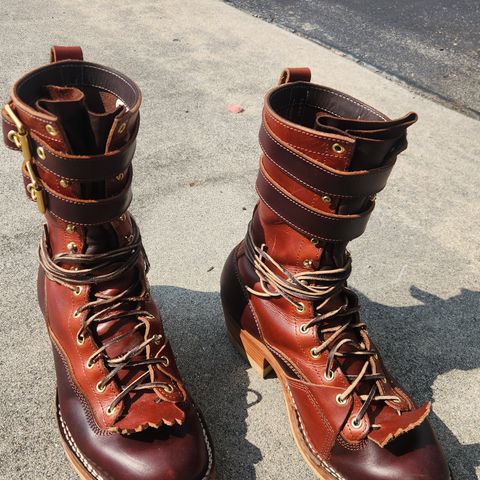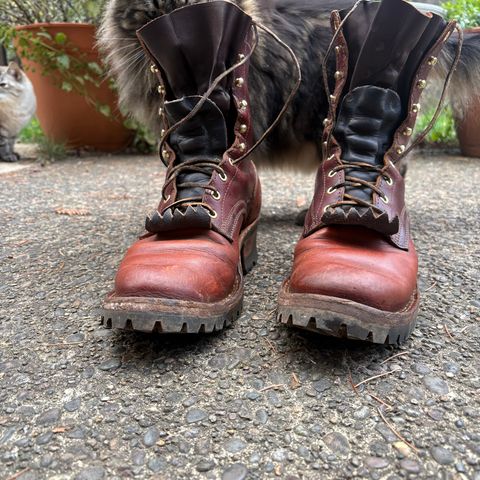About
Wickett & Craig Tan Oiled Latigo is a color variation of oiled latigo leather produced by Wickett & Craig, an American vegetable tannery founded in 1867. The tan color features lighter hues with a pronounced pull-up effect that displays strong character. This leather is hot-dipped in a proprietary mix of oils, waxes, and tallows, making it strong, pliable, and weather-resistant.
About
Wickett & Craig Tan Oiled Latigo is a color variation of oiled latigo leather produced by Wickett & Craig, an American vegetable tannery founded in 1867. The tan color features lighter hues with a pronounced pull-up effect that displays strong character. This leather is hot-dipped in a proprietary mix of oils, waxes, and tallows, making it strong, pliable, and weather-resistant.
The tan variation is one of several colors available in the oiled latigo line, alongside black, burgundy, chestnut, and medium brown. The lighter tan color showcases the pull-up effect more prominently than darker variations, creating visual depth as the leather bends and flexes. Heritage boot makers including Nick's Boots, Caswell Boot Co., and Wesco incorporate this leather into their product lines.
Manufacturing process
The production of Wickett & Craig Tan Oiled Latigo follows the tannery's traditional vegetable tanning process, which takes approximately six weeks from raw hide to finished leather. The process begins with a two-day pre-tanning stage where hides are rehydrated, hair is removed, and excess flesh is eliminated.
The tanning phase spans two weeks and utilizes 72 vats containing a proprietary natural tannin blend that includes bark from Mimosa and Quebracho trees. During this period, the tanning liquor is continuously replenished and recirculated. Hides are split and shaved to achieve the desired thickness and then undergo drum dyeing to achieve the tan color.
Following tanning, conditioning oils and waxes are applied during the fat liquoring stage. The defining characteristic of oiled latigo is the hot-dipping process, where the leather is immersed in a special mix of oils, waxes, and tallows. This treatment packs the leather full of oils and waxes, giving it its distinctive color, temper, and water-resistant properties. The leather is then air dried for three days in a climate-controlled space before being staked to soften the hides.
The tannery sources hides from North American cattle of European stock and uses 100% natural vegetable tanning methods. This labor-intensive process requires skilled workers and produces leather recognized for depth of color and rich patina development.
Characteristics
Wickett & Craig Tan Oiled Latigo is available in weights ranging from 2-3 oz. to 12-14 oz., with a standard thickness of 3.2 to 4.0 mm. The leather combines strength with pliability, making it suitable for applications requiring both durability and flexibility. It is fully conditioned and weather-resistant, with moisture and sweat resistant properties derived from the high oil content.
The leather's texture is smooth with a slightly waxy feel, resulting from the heavy stuffing of oils and waxes during production—far more than harness or bridle leathers receive. This high concentration of oils can cause potential leaching, which users should account for when selecting applications. The leather is more rigid than full chrome-tanned leather but less rigid than traditional vegetable-tanned leather, offering a middle ground in flexibility.
The tan color displays a rich pull-up effect, especially noticeable in lighter colors. This pull-up creates a depth of color that changes as the leather bends, stretches, or is handled. The leather is crafted in both firmer and softer tempers, allowing makers to select the appropriate temper for their specific applications.
Full-grain construction retains the natural surface of the hide, and the leather is designed to endure the elements while maintaining structural integrity. The leather is sold by side and back, with average sides measuring 24-27 square feet and average backs measuring 18-20 square feet.
Aging and patina
As boots made with Wickett & Craig Tan Oiled Latigo break in, the leather gains character and patina that makes each pair unique to the wearer. The break-in period is relatively easy compared to other vegetable-tanned leathers, though once broken in, the leather holds its shape well.
The tan color slowly darkens over the leather's lifetime, developing a beautiful patina similar to other veg-tanned leathers. The leather wears like a saddle, improving with age rather than degrading. This aging process is valued by heritage footwear enthusiasts who appreciate how the leather records its history of use.
The leather may show more marks, scuffs, or stains than some other leathers due to the pull-up nature and lighter color. However, regular conditioning greatly mitigates these effects and maintains the leather's appearance and suppleness. The oils and waxes in the leather contribute to both its aging characteristics and its durability.
Uses
Wickett & Craig Tan Oiled Latigo serves multiple applications in leather goods production. It is considered ideal for strap goods due to its strength and flexibility. When split to lighter weights, it becomes suitable for shoes and bags. Heritage boot makers value the leather for work boots and casual footwear that benefit from weather resistance and patina development.
The leather's high oil content and weather-resistant properties make it appropriate for outdoor applications and gear subjected to the elements. The combination of durability, flexibility, and aging characteristics positions it for products requiring both functional performance and aesthetic appeal over extended use.
References
"Oiled Latigo". Wickett-Craig. Retrieved October 10, 2025.
"Garrett - Tan Oiled Latigo". Caswell Boot Co. Retrieved October 10, 2025.
"The Wickett & Craig Story". Wickett-Craig. Retrieved October 10, 2025.
"Vegetable Tanning". Wickett-Craig. Retrieved October 10, 2025.
"What Is Latigo Leather?". BestLeather.org. Retrieved October 10, 2025.






































































